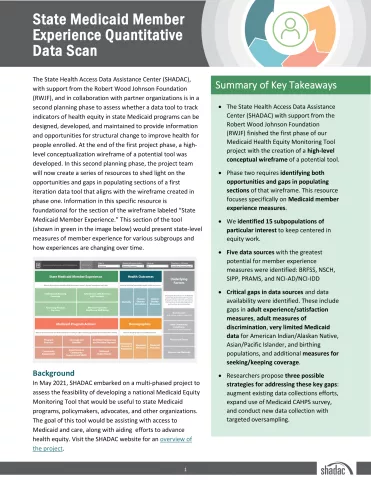As part of the ongoing work in Phase 2 of the Medicaid Equity Monitoring Tool project, SHADAC researchers have been working to understand what available data measures currently exist that could be useful in populating a potential Medicaid Equity Monitoring Tool.
In Phase 1, the project team conceptualized a high-level wireframe, displaying what such a tool could look like, and how measures could be included and categorized. Currently, five general categories have been proposed: State Medicaid Member Experience, Health Outcomes, Medicaid Program Actions, Demographics, and Underlying Factors. These would then be further stratified into varying numbers of domains, under which individual measures could be housed.
To begin a process as large in scope as populating such a data tool, SHADAC decided to narrow our focus and initially concentrate on one potential category area – Medicaid Member Experience. A variety of reasoning went into the decision to start with this category.
- First, since centering the Medicaid member has been, and continues to be, a pivotal focus of all MET project work, so, too, should attempting to understand and represent their experiences be at the center of our measurement data scan and tool population work. We also believe that these data would be the most important in understanding how meaningful these measures are to the Medicaid community members themselves.
- Second, because of SHADAC’s extensive background and familiarity working with a variety of federal surveys and other data sources that support state estimates, we knew where to begin in examining data availability and completeness for existing quantitative data.
After an extensive data and measurement scan focused on Medicaid member experience, SHADAC researchers have compiled their findings thus far into a new resource. This resource highlights a number of key data sources that hold the greatest potential for measuring population in this area, including the Behavioral Risk Factor Surveillance System (BRFSS), the National Survey of Children’s Health (NSCH), the Survey of Income and Program Participation (SIPP), the Pregnancy Risk Assessment Monitoring System (PRAMS), and National Core Indicators – Aging and Disabilities and National Core Indicators – Intellectual and Developmental Disabilities (NCI-AD/NCI-IDD).
Not only that, but this resource also points to critical gaps in availability and existence of data sources and data measures themselves, including highlighting the lack of data stratification for key demographic groups. The resource also details potential measures that would benefit such a tool but are not currently part of any known data collection efforts. Additionally, SHADAC researchers outline several proposals for addressing these gaps with suggested improvements for current data collection efforts/programs alongside proposals for new data collection methods.

